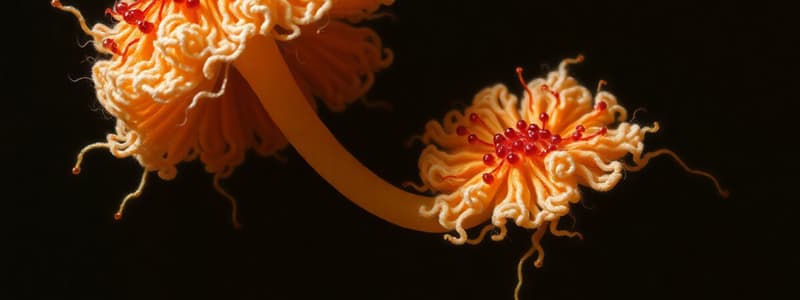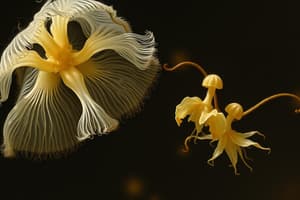Podcast
Questions and Answers
What was the concentration of streptomycin where STM-sensitive growth was observed?
What was the concentration of streptomycin where STM-sensitive growth was observed?
- 1 – 8 μg/ml
- 16 – 32 μg/ml
- 0 – 1 μg/ml (correct)
- 8 – 16 μg/ml
The ⌬1651–1656 and ⌬p19 mutants exhibited a bimodal growth phenotype.
The ⌬1651–1656 and ⌬p19 mutants exhibited a bimodal growth phenotype.
False (B)
What effect did iron supplementation have on the MICs of the mutants?
What effect did iron supplementation have on the MICs of the mutants?
Restored them to wild-type levels of 16 μg/ml.
The wild-type strain of C. jejuni showed a bimodal growth phenotype under streptomycin stress at concentrations of _______.
The wild-type strain of C. jejuni showed a bimodal growth phenotype under streptomycin stress at concentrations of _______.
How did the cell viability of C. jejuni strains change after H2O2 addition in MH alone?
How did the cell viability of C. jejuni strains change after H2O2 addition in MH alone?
Match the mutant strains with their corresponding growth phenotype:
Match the mutant strains with their corresponding growth phenotype:
There were no significant differences between the growth of the wild-type and mutant strains under oxidative stress.
There were no significant differences between the growth of the wild-type and mutant strains under oxidative stress.
What was the role of iron(III) citrate in the study?
What was the role of iron(III) citrate in the study?
What temperature was C. jejuni incubated microaerobically for optimal growth?
What temperature was C. jejuni incubated microaerobically for optimal growth?
C. jejuni is primarily grown in Luria-Bertani broth for selection using kanamycin and chloramphenicol.
C. jejuni is primarily grown in Luria-Bertani broth for selection using kanamycin and chloramphenicol.
What is the purpose of adding extracts to the culture media for C. jejuni?
What is the purpose of adding extracts to the culture media for C. jejuni?
C. jejuni cells were cultured in ____ broth at an OD600 of 0.25 for RNA preparation.
C. jejuni cells were cultured in ____ broth at an OD600 of 0.25 for RNA preparation.
Match the following components with their respective roles in the experiment:
Match the following components with their respective roles in the experiment:
What volume of extract was combined in the MH-TV culture for testing?
What volume of extract was combined in the MH-TV culture for testing?
The planktonic cell concentration was measured from the surface of the liquid culture.
The planktonic cell concentration was measured from the surface of the liquid culture.
How were the biofilms quantified in the experiment?
How were the biofilms quantified in the experiment?
Which gene showed the greatest reduction in expression after 5 hours?
Which gene showed the greatest reduction in expression after 5 hours?
The gene CJJ81176_0685 is associated with chemotaxis.
The gene CJJ81176_0685 is associated with chemotaxis.
What is the significance of a P value less than 0.05 in this context?
What is the significance of a P value less than 0.05 in this context?
CJJ81176_0033 is the locus tag for the gene responsible for __________ synthesis.
CJJ81176_0033 is the locus tag for the gene responsible for __________ synthesis.
Match the following genes with their functions:
Match the following genes with their functions:
Which gene product is a major antigenic peptide?
Which gene product is a major antigenic peptide?
The locus tag CJJ81176_1656 codes for a thioredoxin family protein.
The locus tag CJJ81176_1656 codes for a thioredoxin family protein.
What is the fold change of the gene CJJ81176_0315 after 20 minutes?
What is the fold change of the gene CJJ81176_0315 after 20 minutes?
The gene CJJ81176_1386 is responsible for __________ reductase activity.
The gene CJJ81176_1386 is responsible for __________ reductase activity.
Which of the following genes is associated with sodium:alanine symporter function?
Which of the following genes is associated with sodium:alanine symporter function?
What is the primary transcription start site for the 1649 –1656 genes located relative to the 1649 start codon?
What is the primary transcription start site for the 1649 –1656 genes located relative to the 1649 start codon?
The genes 1648 and 1657 are considered part of the operon consisting of genes 1649 –1656.
The genes 1648 and 1657 are considered part of the operon consisting of genes 1649 –1656.
How many fully sequenced Campylobacter species contain components of the 1649 –1656 system?
How many fully sequenced Campylobacter species contain components of the 1649 –1656 system?
The homologous gene products of the 1649 –1656 system were most commonly found in members of the ______.
The homologous gene products of the 1649 –1656 system were most commonly found in members of the ______.
Match the following bacterial genera with whether they carry the 1649 –1656 system on plasmids or chromosomes:
Match the following bacterial genera with whether they carry the 1649 –1656 system on plasmids or chromosomes:
Which of the following species has not been associated with human illness?
Which of the following species has not been associated with human illness?
The complete genome sequences of 33 phylogenetically diverse bacterial species showed homologues of genes 1649 –1656 exclusively in Actinobacteria.
The complete genome sequences of 33 phylogenetically diverse bacterial species showed homologues of genes 1649 –1656 exclusively in Actinobacteria.
What is the distance in base pairs between gene 1648 and the start codon of gene 1649?
What is the distance in base pairs between gene 1648 and the start codon of gene 1649?
Which gene product is associated with the function of aspartate ammonia-lyase?
Which gene product is associated with the function of aspartate ammonia-lyase?
CJJ81176_1649 has a higher fold change than CJJ81176_1651.
CJJ81176_1649 has a higher fold change than CJJ81176_1651.
What is the fold change for the gene product associated with the 'putative oxidoreductase subunit' after 5 hours?
What is the fold change for the gene product associated with the 'putative oxidoreductase subunit' after 5 hours?
CJJ81176_0885 is a type of ______.
CJJ81176_0885 is a type of ______.
Match the following gene products with their functions:
Match the following gene products with their functions:
Which locus tag shows the highest fold change after 20 minutes?
Which locus tag shows the highest fold change after 20 minutes?
The gene CJJ81176_1392 is associated with cystathionine β-lyase.
The gene CJJ81176_1392 is associated with cystathionine β-lyase.
What is the function of the gene product CJJ81176_1654?
What is the function of the gene product CJJ81176_1654?
CJJ81176_1393 encodes an ______.
CJJ81176_1393 encodes an ______.
Which of the following genes is associated with anaerobic dimethyl sulfoxide reductase?
Which of the following genes is associated with anaerobic dimethyl sulfoxide reductase?
Which of the following bacteria is associated with the case of enteritis in humans?
Which of the following bacteria is associated with the case of enteritis in humans?
Aspartase (AspA) is essential for bacteria to grow under aerobic conditions.
Aspartase (AspA) is essential for bacteria to grow under aerobic conditions.
What is the primary function of the C4-dicarboxylate transporters in Campylobacter jejuni?
What is the primary function of the C4-dicarboxylate transporters in Campylobacter jejuni?
___ is a novel succinic-acid-producing strain from the bovine rumen.
___ is a novel succinic-acid-producing strain from the bovine rumen.
Match the following bacterial species with their notable characteristics:
Match the following bacterial species with their notable characteristics:
What role does AspB (Cj0762) play in Campylobacter jejuni?
What role does AspB (Cj0762) play in Campylobacter jejuni?
The complete genome sequence of Wolinella succinogenes has been analyzed.
The complete genome sequence of Wolinella succinogenes has been analyzed.
Identify the main focus of the 2014 study on bacterial metabolism referenced.
Identify the main focus of the 2014 study on bacterial metabolism referenced.
Flashcards
Operon
Operon
A group of genes that are transcribed together as a single unit, meaning they are controlled by the same promoter and produce a single mRNA molecule.
Promoter
Promoter
A region of DNA located upstream of a gene that binds regulatory proteins, controlling the transcription of the gene.
Fur box
Fur box
A DNA sequence that binds the Fur protein, repressing transcription of downstream genes when iron levels are high.
Fur protein
Fur protein
Signup and view all the flashcards
Primary transcription start site
Primary transcription start site
Signup and view all the flashcards
Protein BLAST
Protein BLAST
Signup and view all the flashcards
Campylobacter
Campylobacter
Signup and view all the flashcards
Plasmid
Plasmid
Signup and view all the flashcards
Bimodal growth phenotype
Bimodal growth phenotype
Signup and view all the flashcards
Monomodal growth phenotype
Monomodal growth phenotype
Signup and view all the flashcards
⌬1651–1656 mutation
⌬1651–1656 mutation
Signup and view all the flashcards
⌬p19 mutation
⌬p19 mutation
Signup and view all the flashcards
Minimum Inhibitory Concentration (MIC)
Minimum Inhibitory Concentration (MIC)
Signup and view all the flashcards
Antibiotic tolerance
Antibiotic tolerance
Signup and view all the flashcards
Iron supplementation
Iron supplementation
Signup and view all the flashcards
Mutant strain
Mutant strain
Signup and view all the flashcards
Growth and biofilm formation in extracts
Growth and biofilm formation in extracts
Signup and view all the flashcards
Aerobic growth conditions
Aerobic growth conditions
Signup and view all the flashcards
Luria-Bertani (LB) broth
Luria-Bertani (LB) broth
Signup and view all the flashcards
Dilution plating
Dilution plating
Signup and view all the flashcards
Liquid growth cultures
Liquid growth cultures
Signup and view all the flashcards
Biofilm
Biofilm
Signup and view all the flashcards
RNA preparation
RNA preparation
Signup and view all the flashcards
Human fecal and chicken cecal extracts
Human fecal and chicken cecal extracts
Signup and view all the flashcards
PEB3
PEB3
Signup and view all the flashcards
Glutamate Synthase
Glutamate Synthase
Signup and view all the flashcards
C4-dicarboxylate ABC Transporter
C4-dicarboxylate ABC Transporter
Signup and view all the flashcards
Di/tripeptide Transporter
Di/tripeptide Transporter
Signup and view all the flashcards
Amino Acid Carrier Protein
Amino Acid Carrier Protein
Signup and view all the flashcards
Sodium:alanine Symporter
Sodium:alanine Symporter
Signup and view all the flashcards
Fumarate Reductase
Fumarate Reductase
Signup and view all the flashcards
Methyl-accepting Chemotaxis Protein (MCP)
Methyl-accepting Chemotaxis Protein (MCP)
Signup and view all the flashcards
Hemerythrin
Hemerythrin
Signup and view all the flashcards
Thioredoxin Family Protein
Thioredoxin Family Protein
Signup and view all the flashcards
What is the function of AspA?
What is the function of AspA?
Signup and view all the flashcards
Explain the function of the DcuA transporter protein.
Explain the function of the DcuA transporter protein.
Signup and view all the flashcards
What does the DcuB protein do?
What does the DcuB protein do?
Signup and view all the flashcards
What is the role of iron permease?
What is the role of iron permease?
Signup and view all the flashcards
What is the function of the periplasmic iron-binding protein (p19)?
What is the function of the periplasmic iron-binding protein (p19)?
Signup and view all the flashcards
What is the role of cytochrome C?
What is the role of cytochrome C?
Signup and view all the flashcards
What does the CJJ81176_0438 gene code for?
What does the CJJ81176_0438 gene code for?
Signup and view all the flashcards
What are ABC transporters?
What are ABC transporters?
Signup and view all the flashcards
Why is there an upregulation of iron uptake genes in cells?
Why is there an upregulation of iron uptake genes in cells?
Signup and view all the flashcards
What does the upregulation of genes related to metabolism, nutrient uptake, and energy production indicate?
What does the upregulation of genes related to metabolism, nutrient uptake, and energy production indicate?
Signup and view all the flashcards
Dipartite iron uptake system
Dipartite iron uptake system
Signup and view all the flashcards
Actinobacillus succinogenes sp. nov.
Actinobacillus succinogenes sp. nov.
Signup and view all the flashcards
Hyperosmotic stress response
Hyperosmotic stress response
Signup and view all the flashcards
Campylobacter lanienae
Campylobacter lanienae
Signup and view all the flashcards
Bacterial methionine biosynthesis
Bacterial methionine biosynthesis
Signup and view all the flashcards
Frischella perrara
Frischella perrara
Signup and view all the flashcards
Aspartase (AspA)
Aspartase (AspA)
Signup and view all the flashcards
Study Notes
Campylobacter jejuni Transcriptional Response
- Campylobacter jejuni is a pathogenic bacterium causing gastroenteritis in humans. It's a common commensal in animals, particularly poultry.
- RNA sequencing was used to study C. jejuni's response to human and chicken intestinal extracts.
- C. jejuni's transcription was altered in response to extracts compared to medium alone. Key changes related to iron uptake, metabolism, chemotaxis, energy production & osmotic stress.
- Exposure to human extracts resulted in higher expression of genes involved in respiration (fdhTU) and iron uptake systems (cfbpA, ceuB, chuC, 1649-1655).
- Genes 1649-1656 and downstream overlapping gene 1656, show these genes are involved in iron scavenging and stress response in the human intestine.
- Homologues of the 1649-1656 system are found in various bacterial species (including 21 associated with human disease).
Iron Uptake System
- Genes 1649 and 1650 (p19) encode an iron transporter and a periplasmic iron binding protein, respectively.
- The 1651-1656 gene cluster is involved in C. jejuni’s iron scavenging.
- A Δ1651-1656 deletion strain has an iron-sensitive phenotype and reduced growth in acidic environments.
- This cluster is vital for optimal growth in iron-restricted environments, utilising human fecal extracts as iron sources.
Host Intestinal Extracts
- Human fecal extracts contain higher total iron content compared to chicken cecal extracts.
- C. jejuni's response to human fecal extracts involved higher expression of iron uptake-related genes and formate dehydrogenase genes compared to chicken extracts.
Studying That Suits You
Use AI to generate personalized quizzes and flashcards to suit your learning preferences.
Related Documents
Description
Explore the transcriptional response of Campylobacter jejuni to human and chicken intestinal extracts. This quiz covers key changes in gene expression related to iron uptake, metabolism, and stress responses as revealed through RNA sequencing. Test your knowledge of the mechanisms that enable this pathogen to thrive in diverse environments.





